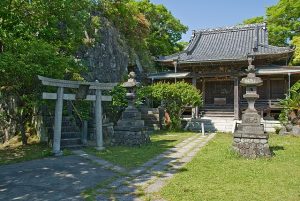38 Shinto-Buddhist Syncretism: 9th – 16th centuries
During the medieval period, Japanese thinkers developed a complex system that combined Shinto and Buddhist figures using Mahayana and esoteric Buddhist ideas. The term, honji suijaku, refers to this relationship between the indigenous deities of Japan, the kami, and the Buddhas. Honji means “original ground”, that is, the primary principle of wisdom. Suijaku means “trace” and indicates the appearance of wisdom in the world. According to Mahayana and esoteric Buddhist thought, the wisdom of the Buddha is a principle that can appear in the world as a temporary manifestation in the form of a Buddha such as Sakyamuni, but the true being of the Buddha is wisdom itself which cannot be destroyed. [See Buddhism chapter for more on this topic].
In medieval Japanese thought, the kami deities were interpreted to be the “trace” of the Buddhas that manifest in Japan. Narratives deliberately linked kami associated with the ruler to the Buddhas. In the case of Dainichi Nyorai, the sun goddess Amaterasu was the trace of the universal Dainichi Nyorai in the world. Amaterasu was also connected with the ritual cult of the ruler, thus making a powerful ideology that linked ruler, kami, and Buddhas together.
Throughout the medieval period narratives that linked kami to Buddhas were promoted by Shinto shrines and Buddhist temples alike. For the Shinto shrines, the link to a Buddha provided the shrine with a learned ideology of salvation that expanded the significance of the shrine. For the temples, the association with local kami helped to anchor the temple in the area and provide a Japanese identity. Buddhist temples commonly had a small Shinto shrine on their grounds; Shinto shrines similarly would build a small temple on their grounds as well. This physical expression of the relationship between the kami and the Buddhas helped to cement the ideology. In the following image you can see the impact on temple design. The photograph shows the temple building of Hosshin-ji in the background. A path leading to the temple is flankd by two stone “lanterns” that light the path. In the left foreground you can see the classic shinto gate and a set of stairs leading to the shrine that is placed on the temple grounds.

Various explanations of the character of the relationship between the Buddhas and the kami were proposed throughout the medieval period. First, the main idea was that the kami themselves, as earthly deities, are also in need of salvation, an attitude towards Hindu deities that had developed in India. Second, the court and ruler especially promoted the idea that the kami are themselves the guardians of Buddhism. Guardian kami images were often placed at the entrance to Buddhist temples. This explanation supported the concept of Japan as a Buddhist country. A third explanation reversed the status of the Buddhas and the kami, declaring that the kami themselves were the true source of enlightenment which the Buddhas temporarily manifest. This explanation helped to support early modern ideologies in which Shinto became a state religion.
